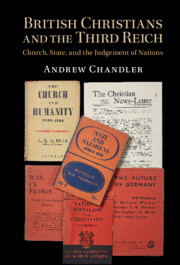Book contents
- British Christians and the Third Reich
- British Christians and the Third Reich
- Copyright page
- Dedication
- Contents
- Acknowledgements
- Introduction
- Part I An Inhabited Landscape
- 1 Observing British Christianity after the Great War
- 2 The Public and Private Worlds of British Christians
- Part II The German National Revolution, 1933–1934
- Part III Resisting a Rapprochement, 1935–1937
- Part IV Crisis, 1938–1939
- Part V The Onslaught, 1939–1943
- Part VI A Gathering Judgement, 1944–1949
- Endings and Legacies
- Bibliography
- Index
2 - The Public and Private Worlds of British Christians
from Part I - An Inhabited Landscape
Published online by Cambridge University Press: 05 May 2022
- British Christians and the Third Reich
- British Christians and the Third Reich
- Copyright page
- Dedication
- Contents
- Acknowledgements
- Introduction
- Part I An Inhabited Landscape
- 1 Observing British Christianity after the Great War
- 2 The Public and Private Worlds of British Christians
- Part II The German National Revolution, 1933–1934
- Part III Resisting a Rapprochement, 1935–1937
- Part IV Crisis, 1938–1939
- Part V The Onslaught, 1939–1943
- Part VI A Gathering Judgement, 1944–1949
- Endings and Legacies
- Bibliography
- Index
Summary
Wilhelm Dibelius was right to observe how many interrelationships were at work in the early 1900s beneath the denominational surface of British Christianity. Many Christians looked, and even longed, for unity in one form or another. In 1918 the Secretary of the Baptist Union, J.H. Shakespeare, had written, ‘The days of denominationalism are numbered. There is nothing more pathetic or useless, in this world, than clinging to dead issues, worn-out methods, and antiquated programmes.’1 It was increasingly the case that the mood was respectful, fraternal and even cordial. Prejudices, even suspicions, lingered – and snobbery, in its various forms, blatant or insidious, remained a barely acknowledged dimension which hovered over much that occurred. But the churches did not campaign against each other, and there were few antipathies. As the Bishop of Durham after 1920, Herbert Hensley Henson could write dismissively in the privacy of his journal about ‘the sects’ but readily accepted invitations to speak to the Wesleyan West London Mission and the General Assembly of the United Free Church in Edinburgh, and was cheered when he went there.2 When a young member of the Faculty of Theology at the University of Oxford (and future Bishop of Oxford), Kenneth Kirk, went on holiday to Polperro in Cornwall, the local chapels shut down for the Sunday evening so that their congregations could go to hear him preach.3 By the 1920s the Congregationalist A.E. Garvie was managing a genuine friendship with Bishop Headlam.
- Type
- Chapter
- Information
- British Christians and the Third ReichChurch, State, and the Judgement of Nations, pp. 20 - 50Publisher: Cambridge University PressPrint publication year: 2022

